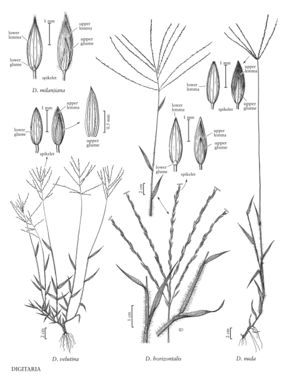Digitaria horizontalis
Plants of indefinite duration; sprawling. Culms to 1 m, erect portion 20-25 cm, decumbent, rooting and branching freely at the nodes. Sheaths usually with scattered papillose-based hairs, hairs more abundant on the lower sheaths; ligules 1.5-1.8 mm, erose; blades 3-14 cm long, 3-9 mm wide, evenly, often densely pubescent adaxially, hairs papillose-based. Panicles with 2-14 spikelike branches attached to 4-15 cm rachises, lower branches whorled, upper branches often paired or solitary; lower nodes with hairs more than 0.4 mm; primary branches 4-12 cm, axes 0.4-0.7 mm wide, wing-margined, wings at least 1/2 as wide as the midribs, often with scattered 1-4 mm hairs proximally, bearing spikelets in unequally pedicellate pairs on the proximal and middle portion of the branches; secondary branches rarely present; shorter pedicels 0.3-0.5 mm; longer pedicels 1.3-2 mm. Spikelets homomorphic, 2.1-2.4 mm, narrowly ovate. Lower glumes 0.1-0.2 mm; upper glumes 1-1.1 mm, 1/3 – 1/2 as long as the spikelets, 3-veined, margins and apices ciliate; lower lemmas about as long as the spikelets, lanceolate, 7-veined, lateral 3 veins on each side unequally or equally spaced, smooth or scabrous over the distal 1/3, lemma margins and the region between the second and third veins densely pubescent, hairs 0.05-0.1 mm, white; upper lemmas slightly shorter than the lower lemmas, yellowish or grayish when immature, becoming light brown at maturity, minutely striate. Caryopses about 1.8 mm, tan. 2n = 36.
Distribution
Puerto Rico, Virgin Islands, Ala., Pacific Islands (Hawaii), Miss., S.C., Fla.
Discussion
Digitaria horizontalis is native to tropical regions of the Americas. It has been found in hammocks and disturbed areas in central and southern Florida and at a few other locations in the southeastern United States, including bal¬last dumps in Mobile, Alabama. It is probably a recent introduction to the Flora region, even in Florida.
Selected References
None.
